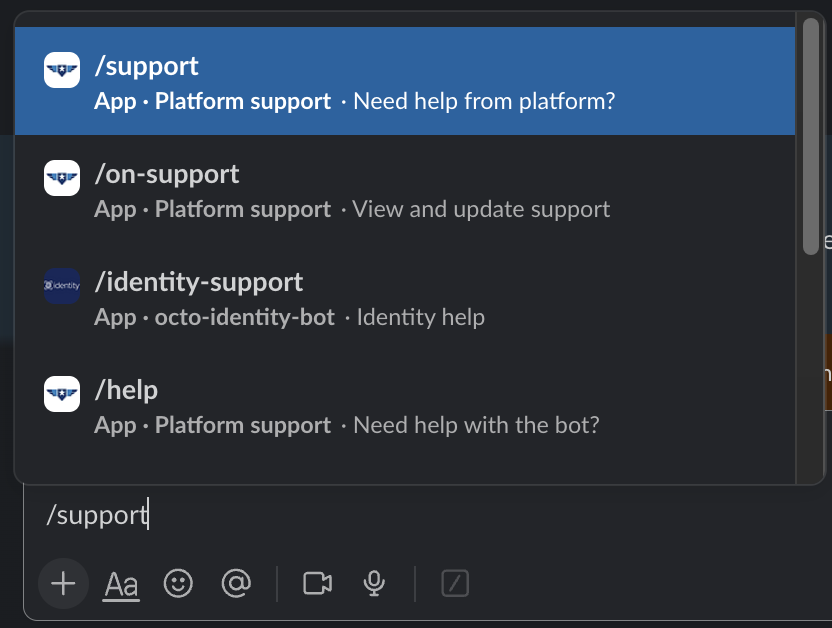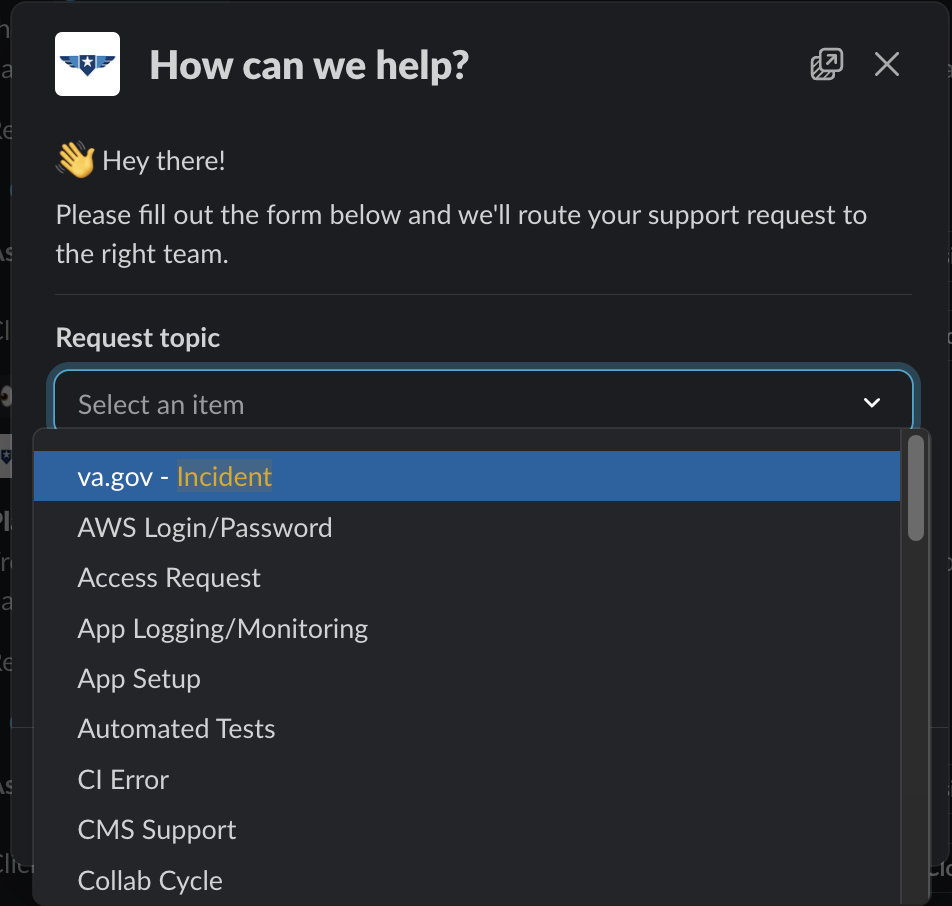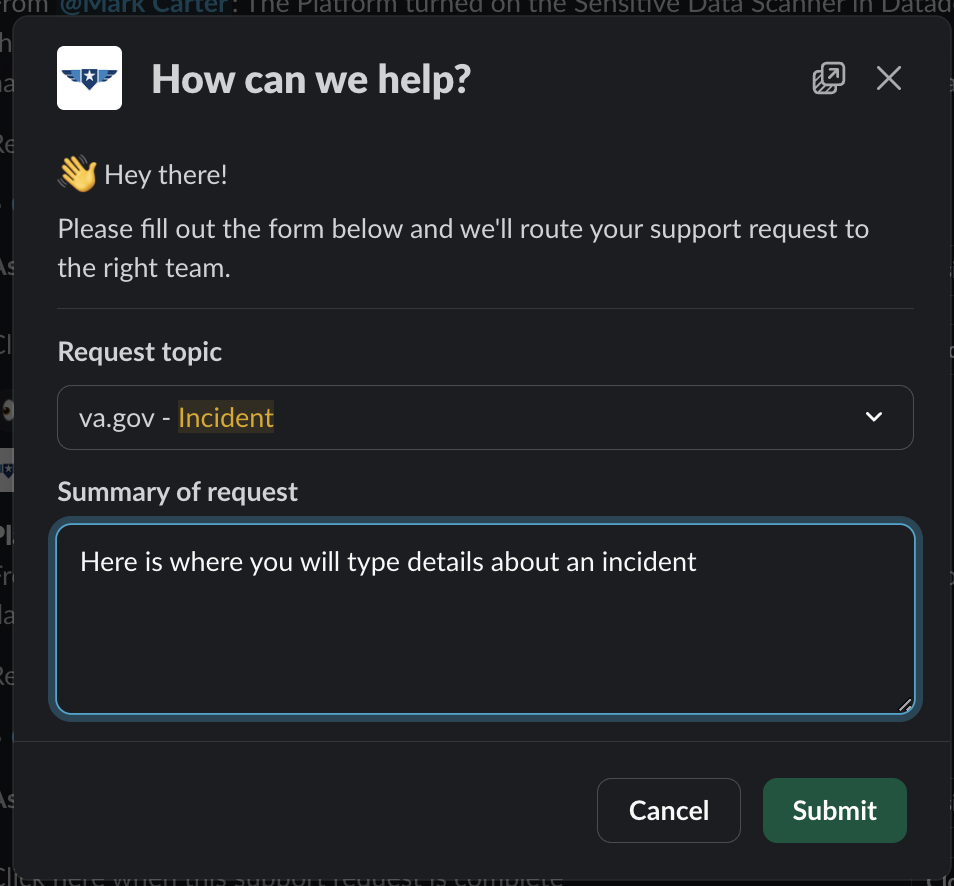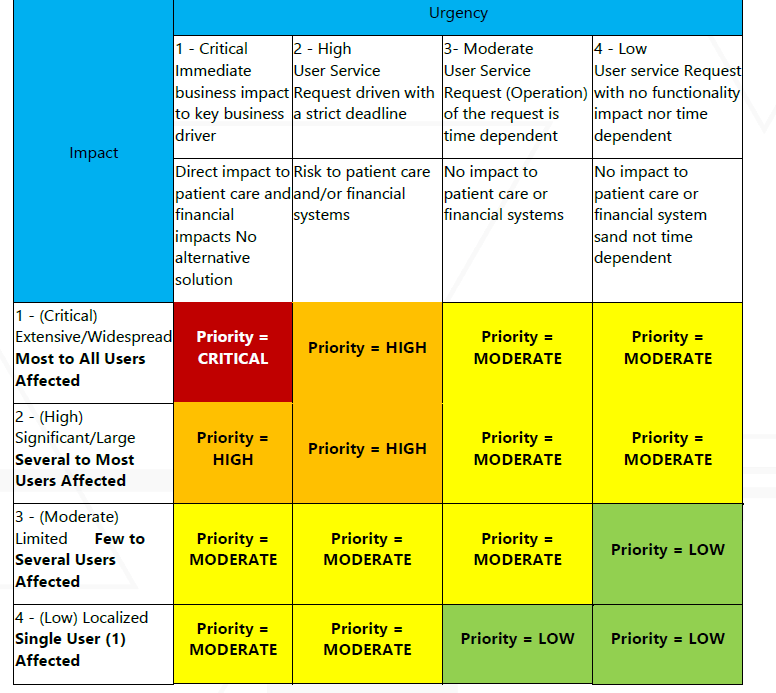VA Platform Incident Playbook
Last Updated:
This document aims to provide clear guidelines on how to handle, communicate, and respond to incidents.
Note: An overview of the process can be found below, under “Incident Flow Chart”
Security Incidents
PII Leaks or Spills
All security incidents must be reported to the ISSO(Griselda.Gallegos@va.gov or 512.326.6037) or the Privacy Office (oitprivacy@va.gov) immediately. Be sure to include the following information:
Who was involved in the issue (including your contact information)
Exactly when the issue occurred (a timeframe, if available)
What systems were affected
When the issue was discovered, and who discovered it.
How many individuals are affected
Types of information leaked, if applicable (SSNs, login credentials, names, addresses, etc).
The Privacy Officer or the ISSO creates a ticket in PSET (Privacy Security and Events Tracking System) https://www.psets.va.gov/. (This ticket is not created by anyone on the Platform)
All incidents will be reported to the VACSOCIncidentHandling@va.gov by the ISSO or the PO within 1 hour of occurrence.
Please include the following people on the email chain: Lindsey.Hattamer@va.gov, brandon.dech@va.gov, lindsay.insco@va.gov, clint.little@va.gov, kenneth.mayo1@va.gov steve.albers@va.gov, steve.albers@va.gov, christopher.johnston2@va.gov
You can track incidents in the DSVA #vfs-incident-tracking channel
VA Platform Process
These steps are an overview for reporting a PHI/PII spill to Platform.
Leaked API Keys
The Vets API and Vets Website repositories are public, VA owned repos that are hosted on GitHub. Many of the external services we interact with require API keys for authentication. During local development, it’s common to temporarily embed these keys in the code. However, this practice can lead to accidental exposure of sensitive keys if committed to source control. This section will explain the Incident Commanders role on handling these types of incidents.
Types of API Keys
API keys can include private keys, OAuth tokens, Bearer tokens, and more. These credentials are often used for authentication and authorization when interacting with external services on the VA Network or adjacent APIs (such at Lighthouse).
Response Plan
Leaked API keys are often discovered during PR reviews, where a reviewer (Platform or VFS) may notice sensitive information committed in code. Upon identifying a leaked key, follow the Incident Commander process:
Trigger an incident in PagerDuty, and escalate to Backend on-call. Or, if during business hours utilize Backend support.
Notify OCTO leadership in the #vfs-incident-tracking channel.
After the key is rotated, Backend will need to roll pods in EKS to ensure they pick up the new key.
Important note on downtime: Revoking the compromised key may cause downtime or disruptions to services that rely on it, until the new key is in place. To minimize impact, ensure any configuration files, environment variables, or secret management values are updated as soon as possible with the new key.
For external services integrations using the Breakers middleware pattern, an outage can be force triggered to manage disruptions. This mitigation strategy will additionally require scheduling a maintenance window in PagerDuty and may also involve placing a temporary banner on the frontend to notify users about the service impact.
If Rotation is delayed, please see the next section.
Again, this may result in downtime until a new key can be integrated.
If you feel comfortable, you can follow triggering Breaker outages for EKS Environments. If not, you can tap the Backend engineer to help with this. This follows the first bullet point in the warning panel above.
Using the list from
bundle exec rake breakers:list_services, you can cross-reference this with the Service Directory in PagerDuty. We will want to setup maintenance windows for any of the affected services.Reach out to the Content and Information Architecture team in the #content-ia-centralized-team to facilitate setting up a banner on the frontend to inform users about service impact.
After the incident has been resolved, create a postmortem to document the incident.
Incident-handling steps
:announcement: These steps are an overview. See further down the page for more details if needed.
Determine if the issue is a major outage of va.gov or a limited impact incident, if possible. See Classifying the Incident section below.
Minor incidents don’t need to follow the reporting outlined on this page.
If you are NOT the Incident Commander (IC) and need to page the IC, create a support ticket in the DSVA Slack channel, #vfs-platform-support by using the
/supportcommand and use theincidenttopic.
The Incident Commander will confirm the incident.
For major incidents, the IC must notify @channel on significant status change or every three hours in the following channels:
For security incidents, the IC must escalate the incident to Tier 3 (Lindsey Hattamer and Ken Mayo). Follow the steps in the “Security Incidents” section
The Incident Commander and subject matter experts work together.
The engineer will focus on resolving the incident (see Triaging an Incident section below).
A technical lead will act as the SME for issues related to the incident.
The Incident Commander will focus on the communication steps outlined in this document Please review the difference between a Swarm Room and a MIM Bridge
Classify the incident and escalate if needed.
Start a Team Swarm Room if required.
Provide updates in incident threads in the above channel as more details emerge.
Once the Incident is resolved, publish a postmortem.
Triaging an Incident
Triaging an incident in the VA Platform can be difficult due to the complexity of the systems, teams, and infrastructure involved. The following suggestions are steps that may be taken by the IC or Tier 2 on-call engineers when troubleshooting.
Take notes and document the troubleshooting steps taken in the Slack thread or channel where this is being discussed.
Note: ✔️ Denotes an action to take when triaging an incident.
⬇️ Click below for triaging steps ⬇️
Incident Areas of Concern
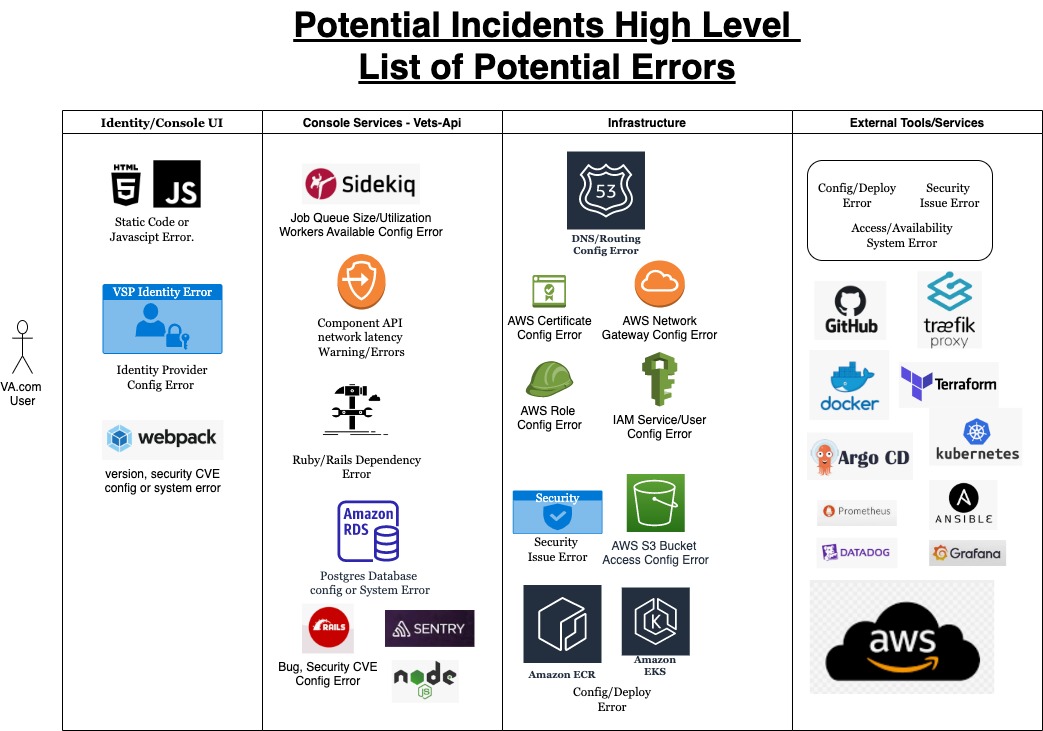
Areas where things could go wrong
Classifying the Incident
The first step to take when an incident occurs is to classify it based on impact and severity. Incidents are handled differently, depending on how many users are affected and whether significant functionality is lost on va.gov.
Severity | Description | Urgency |
|---|---|---|
Critical |
| Drop everything and work around the clock to fix the issue. Incident Commander should immediately open a Swarm Room and consider contacting the MIM team for an HPI declaration |
Major (High) |
| Drop everything and try to get the issue fixed ASAP. Incident Commander should immediately open a Swarm room and consider contacting the MIM for an HPI declaration. Clarify need for MIM with OCTODE leadership |
Medium (Moderate) |
| Try to fix the problem ASAP. Incident Commander should offer to open up a Swarm Room, but may not be necessary. |
Minor (Low) |
| Try to fix the problem ASAP, but not necessarily evenings and weekends. |
External |
| |
Not an Incident |
|
Designating an event as an Incident, including ones designated as Minor, indicates the seriousness of the issue. The Platform has a sense of urgency around resolving all Incidents.
High Priority Incidents (HPI) and Major Incident Management (MIM)
If you believe this is a high priority incident (HPI) based on the above criteria, or by using the incident flowchart, please follow the steps in the Major Incident Management Playbook
External Incidents handling
External Incidents are treated differently than internal ones. Some examples might include Datadog or GitHub being down. You can post a message in #vfs-platform-support as you see fit.
Note: The rest of this document focuses on internal Incidents.
Roles
All Incidents must have:
Incident Commander
Support Team TL: Brandon Dech (backup: Lindsay Insco)
TL from the team who owns the broken service: Curt Bonade, Steven Venner, Ken Mayo (Or designated backup)
Program Manager: Andrea Townsend (backup: Em Allan)
A senior team member (TL or senior) who is not hands-on resolving the issue but can provide clear, timely updates. They must be able to answer questions from the MIM team about the incident and status of resolution. This person should bridge communication between the Swarm Room and the MIM Bridge.
This should be a TL or a Senior member of the team (For example, Kyle for IST, or Curt for SRE.)
Engineering Lead: Lindsey Hattamer (backup: Clint Little)
VA Technical Leadership: Steve Albers (backup: Andrew Mo?)
VA Product Leadership: Erika Washburn (backup: Marni)
If you are named as required and you cannot attend, you must designate who your backup is in the Platform Leadership channel in slackmmander (IC)
Communication
Communication is the main job of the incident commander.
As a rule, no escalation is needed for minor incidents but the IC can choose to escalate at their discretion.
Slack
After notifying the channels listed in above in the Incident-handling steps section, communication should happen at least hourly in the #vfs-incident-tracking channel.
The IC’s job is to keep Leadership updated with the current status of an active incident at least every hour with the following:
The current state of the service
Remediation steps taken
Any new findings since the last update
Theory eliminations (i.e. ‘What have we determined is not the cause?’)
Anticipated next steps
ETA for the next update (if possible)
If OCTODE Platform Leadership is not reachable on slack, text them one at a time - beginning with Steve Albers - using the phone number from their slack profile.
If Slack is down, use the contact list and info in PagerDuty.
Swarm Room and MIM Bridge
Please follow the guide on Swarm Rooms vs MIM Bridges for more information on rules and etiquette.
External VA Service Outages/Incidents
If an issue with an external VA service is detected (TIC, MPI, BEP, VBMS, etc) you will need to file a Service Now (SNOW) ticket. The Incident commander should assist in filing this.
If an issue with the TIC gateway is identified, the team has been encouraged to reach out to Ty Allinger - a Network Edge Operations engineer directly on Teams to attempt to troubleshoot live. If Ty Allinger is out of office, Lawrence Tomczyk is the backup manager after you file an Incident Ticket and assign it to NETWORK.NOC.NEO
Out of band deploys approval
Fixing a problem related to an incident might require deploying code outside of the daily-deploy schedule for emergencies. As a rule, out-of-band deployments requested from VFS teams require OCTODE platform leadership.
When you are requested to complete and out-of-band deployment for an urgent issue, ask the requester to complete an OOB deploy request ticket (here). Once the ticket is created, create an incident in PagerDuty under “Out of Band,” link the slack request thread, and escalate it immediately. It might be helpful to link the OCTODE member to the existing thread as well. Tag Lindsey Hattamer and Brandon Dech in out-of-band threads.
The on-call OCTODE member will respond and either approve or deny. From there, reach out to the appropriate Tier 2 team member to review, approve/give feedback if necessary, and merge.
The team will need to create a post-mortem for the issue.
Off-cycle deployments are not synonymous with out-of-band deployments. Off-cycle deploy requests are for VFS teams to coordinate with the Platform crew to deploy non-urgent work off-hours to minimize impact to Veterans for planned changes to work.
After the Incident
Once the Incident is resolved, follow the instructions to create a postmortem document. Get a draft up within 24 hours.
Incident Retrospective Process
OCTODE leadership may request that the Incident Commander schedule a retrospective meeting to bring all relevant parties together and discuss the PM while it is still in draft form. The intent of the meeting is typically to review and go through the details of the PM.
The postmortem document should be as complete as possible prior to the discussion. This should be treated as a call to cover the final draft.
Ensure that your meeting invite description includes:
A link to the post-mortem document
A short message explaining the reason for the meeting (e.g., “A retrospective to cover this post-mortem. Please feel free to reach out about any other discussion items or if you would like anyone else invited.”)
Be sure to send the meeting invite to Lindsey Hattamer, Brandon Dech, Andrea Townsend, Erika Washburn, Chris Johnston, Steve Albers, and any additional stakeholders involved or interested. Use VA.gov email addresses only. You may forward the invite to your company email address for visibility.
Julia Gray and Erica Robbins work closely with Chris Johnston and can assist you with finding time in his schedule for incident postmortems he requests (HPIs for example). They are available in Slack.
To keep the meeting efficient, consider including an agenda based on the titled topics from the PM. This can serve as a guideline to help facilitate the discussion.
During the call, the Incident Commander should share a link in the chat to the postmortem document, and begin sharing their screen with the postmortem open for review. The Incident Commander will walk the attendees through the postmortem section-by-section, and open the floor for discussion. The IC or another member of the Platform Support team should be working to take detailed notes so that the document can be updated.
Additionally, any action items that require issue tickets should be listed in the table of the postmortem and following the meeting, be created ASAP.
After notes taken from the discussion are added to the postmortem document, it can be taken out of draft mode, and you can request Steve Albers to review.
Incident Flow Chart

Resources
Incident Call Rules: Swarm Room vs. MIM Bridge
MIM SOP (Only accessible behind VA network [CAG, AVD, GFE])
YourIT Helpdesk Article (Only accessible behind VA network [CAG, AVD, GFE])

